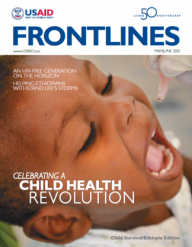Over the past decade, we’ve made tremendous strides to reduce child mortality across the world, thanks in large part to the scaled up distribution of proven interventions and new technologies that are making it easier to reach and save more children.
In Ethiopia, where families have had to contend with one of the highest rates of infant and child mortality in the world, we’ve seen a dramatic and rapid decline. Between 2006 and 2010, infant mortality decreased by 23 percent and under-5 mortality by 28 percent. These achievements are largely a result of Ethiopia’s investment in a community health system and a cadre of 35,000 heath workers who provide front-line care. In a nation where only 10 percent of births occur in health facilities, community health workers—skilled in birth attendance and equipped with affordable tools to save the lives of mothers and newborns—serve a critical role.
But despite this significant progress, one in 11 children in Ethiopia do not live beyond their fifth birthday. And across the world, 7.6 million children under age 5 die every year because they do not have access to basic life-saving interventions like vaccines and bed nets. An additional 370,000 children are born every year with HIV, transmitted by their mothers.
In order to realize the vision of ending preventable child deaths, we need to work more effectively and efficiently than ever before. We have to overcome barriers to greater success, transforming facility-dependent programs designed to treat diseases into community-driven programs focused on treating patients.
This effort begins even before the moment of birth. Through the President’s Emergency Plan for AIDS Relief, we are ensuring pregnant HIV-positive women can give birth to an AIDS-free generation. On World AIDS Day in 2011, President Barack Obama announced that the drop in the cost of a year’s supply of AIDS medication—from $1,100 to $335—allows us to provide lifesaving medication to 6 million people.
Because many infants die from asphyxia during their first “golden minute” of birth, our Helping Babies Breathe partnership is equipping midwives and caregivers with low-cost tools that can help newborns take their crucial first breaths. And thanks to the dramatic scale-up of malaria prevention and treatment efforts under the President’s Malaria Initiative, we have seen extraordinary results in child survival around the world. In Senegal, child mortality declined by 40 percent in five years, largely because preventing children from contracting malaria creates a cascade of other lifesaving health benefits.
It is only recently that we began to understand the long-term societal consequences of widespread stunting—or how easily an effort like breastfeeding or child nutrition could fight this hidden hunger. To support these simple, effective and lifesaving interventions, our 1,000 Days Partnership is shifting our nutrition efforts to focus on the critical window between a mother’s pregnancy and her child’s second birthday.
This past summer, when children arrived with their families at the Dadaab refugee camp in Kenya, they received polio, measles and pneumococcal vaccines at the point of registration. It was only recently the world came together to help ensure that children everywhere have access to the latest vaccines that will protect them against pneumonia and diarrhea, the two leading causes of global child death.
By working closely with countries and continuing smart investments in global health, we can bring the rate of child mortality in poor countries to the same level it is in rich countries. This tremendous achievement would not only save millions of lives, but would help nations accelerate economic growth through a shift in their population called the demographic dividend. As children live longer and family sizes decrease, the productive share of a population rises, with the percentage of those able to work—usually those between ages 15 and 64—much larger than the share of the very young or very old. Along with smart economic and labor policies, that demographic pattern can add as much as two percentage points of growth for years.
Development is full of problems we have few ways to solve. Helping children reach their fifth birthday is not one of them.










Comment
Make a general inquiry or suggest an improvement.